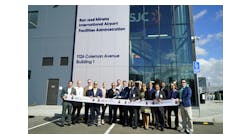What Are Federal Grant Assurances and How Do They Impact Our Nation’s Airports?
Presently, there are approximately 2,800 federally obligated airports in the United States. On May 13, 2021, the FAA announced the award of more than $898.9 million in infrastructure and safety projects to be distributed this year through the Airport Improvement Program (“AIP”). These grants include 488 grants to 447 airports in 49 states and three U.S. territories. Over the last 75 years, the FAA has issued more than 89,000 grants totaling $96 billion. The receipt of these grants does not come without obligations and those obligations have significant impact on the airports that receive the grants. This article will give a brief overview of those obligations and the impact that it has on our country’s airports.
The Federal Aviation Administration (“FAA”) administers the AIP and other grants issued under predecessor programs including the Federal Air to Airports Program and the Airport Development Aid Program. AIP grant monies can be used for airport planning, airport development, noise compatibility projects and planning. The funds received through these programs benefit airports around the nation. In exchange for receiving AIP funds the airport must agree to comply with federal grant assurances. These grant assurances remain consistent and include such obligations as: (1) maintaining good title to the airport (Grant Assurance 4); (2) preserving rights and powers to control and operate the airport (Grant Assurance 5); (3) requirements relating to operation and maintenance of the airport (Grant Assurance 19); (4) hazard removal and mitigation (Grant Assurance 20); (5) provision of facilities for air traffic control and weather (Grant Assurance 28); (6) maintaining an Airport Layout Plan approved by the FAA (Grant Assurance 29); (7) requirements that the airport be available on reasonable terms without unjust discrimination (Grant Assurance 22); (8) prohibition against exclusive rights (Grant Assurance 23); (9) maintaining a fee and rental structure that makes the airport as self-sustaining as possible (Grant Assurance 24); and (10) restrictions on the use of airport revenue (Grant Assurance 25). The FAA may also attach additional obligations intended to address or remedy a specific situation at an airport. The grant assurances are designed to protect the Federal Government’s investment at specific airports and further protect the public’s interest in civil aviation. These grant assurances are set forth in the application for grant monies and become binding on the airport when it accepts federal funds for airport development.
Generally, the obligations remain in effect throughout the useful life of the improvements constructed with the grant monies not to exceed twenty years. In the case of privately owned airports that receive federal funds, the useful life cannot be less than 10 years. “The useful life of a federally funded airport development project extends for the period of time during which it is serviceable and usable with ordinary day-to-day maintenance.” FAA Order 5190.6B(4.4). It should be noted that the useful life does not shorten because the improvement was allowed to deteriorate. It is up to the FAA’s regional airports divisions to determine if the useful life of a specific improvement has expired. If an airport has a question as to the length of the useful life of a particular improvement, the airport can reach out to the FAA’s regional airport division responsible for the region where the airport is located.
“There are three Grant Assurances for which the obligation continues without limit as long as the airport is used as a public use airport.” FAA Order 5190.6B (4.3). The three grant assurances that continue without limit are Exclusive Rights (Grant Assurance 23); Airport Revenues (Grant Assurance 25); and Civil Rights (Grant Assurance 30). “In cases where land was acquired with federal assistance, the federal obligations relating to the use, operation, and maintenance of the airport generally remain in perpetuity.” FAA Order 5190.6B (4.4). As long as an airport is federally obligated, it must abide by the conditions and obligations it accepted when it received the federal assistance.
Among other things, the grant assurances require that the airport (1) be maintained in accordance with applicable standards, (2) ensures there is no unreasonable discrimination among users or tenants; (3) charges fair and reasonable rates that make the airport as self-sustaining as possible; (4) prohibits the granting of exclusive rights; and (5) requires that airport revenue be used for “the capital or operating costs of the airport, the local airport system, or other local facilities owned or operated by the airport owner or operator and directly and substantially related to the air transportation of passengers or property.” FAA Order 5190.6B(15.9). These grant obligations are the reason why airport leases contain clauses including: making any lease subordinate to the grant agreements, prohibiting exclusive rights, creating revisionary interests in improvements, and limiting terms and options. It is also the reason why most airports have minimum standards.
The FAA’s airports district offices and regional airports divisions are charged with responsibility for ensuring that the airports comply with their obligations. The FAA monitors and enforces compliance in the following ways: (1) educating airport managers and personnel; (2) surveillance/monitoring for compliance; and (3) investigation of potential violations.
The FAA’s educational efforts include: (1) offering assistance to airports in maintaining and achieving compliance with the federal obligation; (2) meeting with sponsors when they receive grants or transfers of property to make sure they understand the obligations; and (3) offering periodic seminars and courses for airport personnel and encouraging participation. Additionally, any federally obligated airport may reach out to the FAA’s regional airports division and seek advice with respect to maintaining compliance.
The FAA’s surveillance and monitoring for compliance includes: (1) airport site visits; (2) information requests from the airport, other FAA offices, state agencies, and airport tenants; and (3) reviewing the required reports submitted by airports.
The FAA may learn of a potential violation through its own monitoring efforts or it could be alerted to the potential violation through a request from the airport for guidance, an informal complaint made through the process outlined in 14 CFR Part 13 (a “Part 13 Complaint”) or a formal complaint through the process set forth in 14 CFR Part 16 (a “Part 16 Complaint”).
Pursuant to 14 CFR §13.11, any person who knows of a violation of the grant assurances may make a report to the FAA. The report is usually made to the compliance specialist in the regional airports division. The party making the report does not necessarily need to be impacted by the violation in order to report the violation. The report may be made verbally or in writing. Once received, the FAA will provide the airport with an opportunity to respond. The FAA may request further information and materials from either the airport or the complaining party in order to identify whether a violation has occurred. The FAA will clarify the rights and responsibilities between the parties and offer assistance in resolving the matter in a fashion consistent with compliance. If a mutually agreeable resolution consistent with the grant obligations is not possible, the FAA may issue a preliminary determination. If the preliminary determination finds no violation, the matter will be closed. If the preliminary determination results in a finding of a violation, however, the FAA will request that the airport provide a corrective action plan to correct the areas of non-compliance. If the FAA cannot resolve the matter through reasonable efforts at voluntary compliance, it may exercise additional remedies including proceeding with a Part 16 Complaint.
The FAA requires that the Part 13 Complaint be addressed in 120 days. Notwithstanding that, the process usually takes longer although not as long as the more formal Part 16 process which often takes several years.
The process for a Part 16 Complaint is more formal, and strict adherence to the regulations is required. Only parties who have been directly impacted by the airport’s alleged non-compliance are permitted to file a complaint. Additionally, the complaining party must engage in a good faith attempt to resolve the matter with the airport prior to submitting a Part 16 Complaint. Failure to strictly adhere to the regulations will result in dismissal of the Part 16 Complaint. Upon receipt of a Part 16 Complaint that meets the requirements set forth in the regulations, the FAA will request that the airport provide a formal written response. Thereafter, the FAA will review and conduct any additional investigation deemed necessary before issuing a formal determination. In the event that the FAA finds a violation, the FAA will request that the airport engage in corrective measures designed to restore compliance. If the airport refuses to engage in voluntary corrective measures, the FAA can exercise remedies including withholding federal funding or commencing legal action aimed at achieving compliance.
The grant assurances can be simply viewed as strings attached to the federal funds that are distributed to airports across the country annually. They ensure a level playing field for competition among all airport users and tenants and also provide recourse when an airport fails to comply.
Alison L. Squiccimarro is an attorney with the Law Offices of Paul A. Lange, LLC with offices in New York and Connecticut. Alison’s nationwide practice focuses on aviation related commercial litigation with an emphasis on FAA and DOT Regulatory Issues, Airports, Insurance Coverage and Employment matters. Additionally, Alison co-chair’s the American Bar Association, Forum on Air & Space Law’s Airports Committee.





